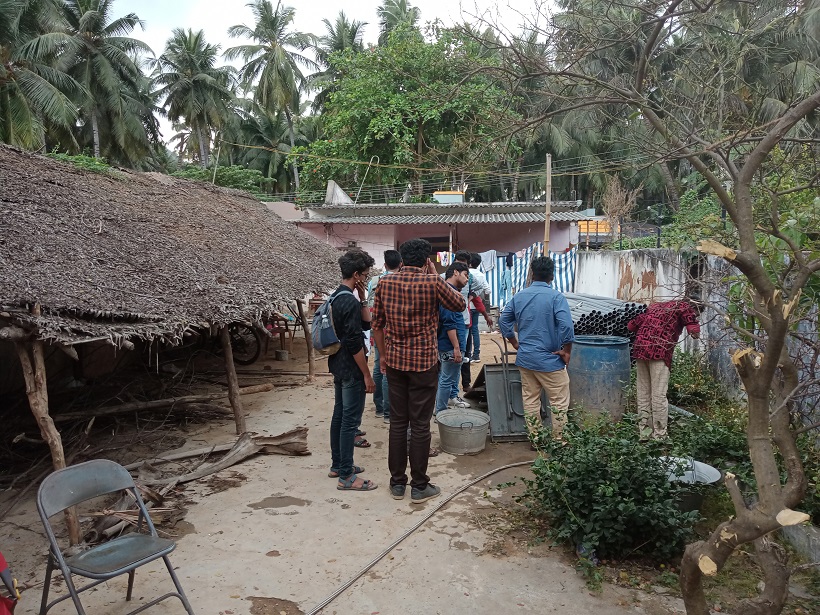Excavations continue at Valasai, Gudiyatham exposing interesting evidences to prove Neolithic Ashmound to Iron period

Archaeological field-training to the students: The first year students of M.A., Ancient History and Archaeology of the University of Madras were taken to Chenthur Malai, Valasai Village – 632601, near Modikuppam, Gudiyatham Taluk, Vellore District, for field-training in excavation. On 20-02-2021, morning, the University bus started from the University campus and proceeded to Gudiyatham via Vellore.

In between, we had breakfast at a hotel and proceeded.

Valasai village, location and significance: Valasai is surrounded by K.V. Kuppam Block towards East, Anaicut Block towards South, Bangarupalem Block towards North , Yadamari Block towards North. That is it is near to Karnataka and Andhra borders and therefore, the ashmound found here is reasonable, plausible and conforming the pattern and life-style of the Neolithic cultural sequences with iron technology. In 1980, 2006 and 2012, earlier excavations were carried on and the presence of Neolithic culture was proven and I have given those details in my earlier blog[1].

The students briefed about: The students were headed by Prof J. Soundararajan, HOD-In-Charge, P. Venkatesan, ASI retd.officer, Jinu Koshi, the site-guide for excavation and others. We reached the site by 1.00 pm. The Valasai village has been calm and the people have engaged in agriculture.







After having lunch, we proceeded to the ashmound area. The students were briefed about the “ashmound,” is significance and fin at the Valasai village.









The ashmound etc: The hillside was cut to prevent the wild animals to enter the agricultural land and spoil and also affect the villagers with their sudden visits. Recently, elephants in group entered the village and damaged the banana trees and crop.

The above photo shows the ashmound presence in the straigraphical layers. The photo below shows the ashmound with the embedded pottery pieces in situ.
Jinu Koshi claimed, “…….that the Ashmounds were formed by accumulation of burned dung in the pastoral settlements during the neolithic period. The earliest date and occurrence of these ashmounds dates back to 2,500BCE”, adding, “The site was visited by Arcahelogical survey of India in 2012 to understand the cultural sequences and importance of the site. Later in their study it was confirmed the site was occupied since neolithic period. Based on the thesis report and the study conducted by ASI, we decided to excavate the site…. The main aim of this excavation was to understand the antiquity and culture of ancient Valasai. Another purpose is to find out the extension of the settlement and its pattern. A systematic archaeological excavation of this mound will unfold the cultural importance and history of this region. Besides, the findings of the excavation would also help in reconstructing the history of south India.”
In Karnataka, the ashmounds are typically called as “Budhihal” (place of ash), “Budditippa” (mound of ash), “Budigunta” (pit of ash), “Budikanama” (abode of ash) etc., thus clearly pointing to ash.
The students engaged in excavation and waiting for the HOD instructions to get ready, as could be noted from the photograph.
How the area was marked for excavation was divided into squares and digging started for prospective findings. As the area has already proven for the archaeological potential, it has been chosen for field-study and excavation-training.

What is Step-trench excavation?: Here, Step-trench excavation method is adopted incorporating both vertical and horizontal excavations. Moreover, the mound contains soil, mud and earth are fund to be loosely packed.

In deep excavations the side of the trenches may be stepped at intervals in order to maintain the stability of the trench walls and reduce the risk of collapse. An inevitable consequence is that an excavation that starts relatively large will provide only a limited view of the deepest levels.

A trench is a type of excavation or depression in the ground that is generally deeper than it is wide (as opposed to a wider gully, or ditch), and narrow compared with its length (as opposed to a simple hole).
The different types of tools used in an excavation: The different tools used in the excavations have been –
| Spade Pick axe Shovel Rammer Crow bar Wedge | Spading fork Hoe Rake Basket Iron pan Brushes |


The pottery, and other materials embedded can be seen on the LHS portion insitu (not yet excavated) and the RHS portion shows the just excavated position of the stratigraphy.
Interestingly, the students could find “Ash mound” with the stratigraphical layers embedded with broken pottery and skeleton pieces of the animals. The mound excavated evidently contains loose soil with the embedded materials. They could also note the unearthed potsherds and stone tools dating back to Neolithic, iron age and early historic periods, implying that the area had been perhaps, continuously engaged with human activities.
© K. V. Ramakrishna Rao
23-02-2021
[1] K. V. Ramakrishna Rao, Valasai: Neolithic site, excavations carried on, evidences found including ash mound and their significance thereof!, February 11, 2021.
Valasai: Neolithic site, excavations carried on, evidences found including ash mound and their significance thereof!
Filed under: ash, ash mound, ashmound, budhigunta, budhihal, budhikanama, budhitippa, budi, budigunta, budihal, budikanama, buditippa, c-14, carbon, cattle, cattle keepers, cattle raiders, chalcolithic, chola, cholas, circle, date, dating, evidence, historicity, historiography, history, Iron, iron ash, iron slag, iron smelting, megalith, megalithic, neolithic, neolithic cattle keepers, neolithic cattle raiders | Tagged: archaeology, ash mound, ashmound, basket, budhi, budhigunta, budhihal, budhikanama, budhitippa, budi, budigunta, budihal, budikanama, buditippa, crow bar, excavation, hoe, iron pan, pick axe, pins, rake, rammer, rope, shovel, sledge hammer, spade, step trench, trench, wedge | 2 Comments »

